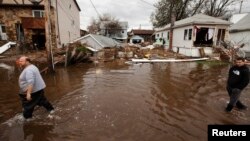“There’s a real threat to our future,” says Daniel Bader, project leader and co-author of an alarming new report by the New York City Panel on Climate Change.
The report's predictions include many more heat waves, extreme storms, and a likely rise in sea levels of between 10 and 28 centimeters by the 2020s — up to 78 centimeters by the 2050s — flooding parts of the city and surrounding regions. The average temperature in New York will rise more than 2 degrees Celsius by midcentury and nearly 5 degrees Celsius by the 2080s, according to the report.
The city has been preparing, especially since Superstorm Sandy, Bader noted, taking measures to reduce its own carbon emissions and to protect against rising waters by restoring wetlands in the outer boroughs, building sea walls and berms, and strengthening transportation and utility infrastructures.
VOA News spoke with Bader, of NASA’s Goddard Institute for Space Studies and Columbia University. His remarks, edited for length:
“The two primary climate risks for New York City, as we head toward the middle of the century, are extreme heat — higher temperatures, more frequent and intense heat waves — as well as sea level rise and increased coastal flooding. Just by increasing sea level rise alone, your frequency of coastal flooding will change — absent any changes in storms themselves — so just that rise in water is going to cause an event that may [be] rare now [but] occur more frequently in the future.
"The primary short-term risk that we face is warming temperatures, and the impacts of extreme heat events, high-temperature events in the summers, heat waves [that] we define as three or more consecutive days over 90 degrees.
"New York City is a worldwide leader when it comes to responding to climate change, and the actions that we’re taking in our city can serve almost as a role model to cities globally. We base our work and interact with cities globally as well, see what they’re doing, and take from them and what we can bring home to our city.
"They’re looking at ecological approaches to adapting to climate change, and policy-related changes in building and design codes ... and the hard infrastructure, building or moving structures out of the flood plain, for example. [But] the challenges of climate change in our area are much less severe than, say, a developing nation where the infrastructure to respond is so limited in the first place.
"There’s a real threat to our future. These changes that are projected to occur will impact our day-to-day lives, and the New York City climate change panel emphasis is mostly on infrastructure, because we’re an urban environment. But certainly the impact to ecological systems, to human populations, is real as well, and it’s something that’s already being considered by the city.
"One of the new features in the NPCC 2015 report is the chapter on public health risks, the key climate hazards to public health being coastal storms and extreme temperatures.”








